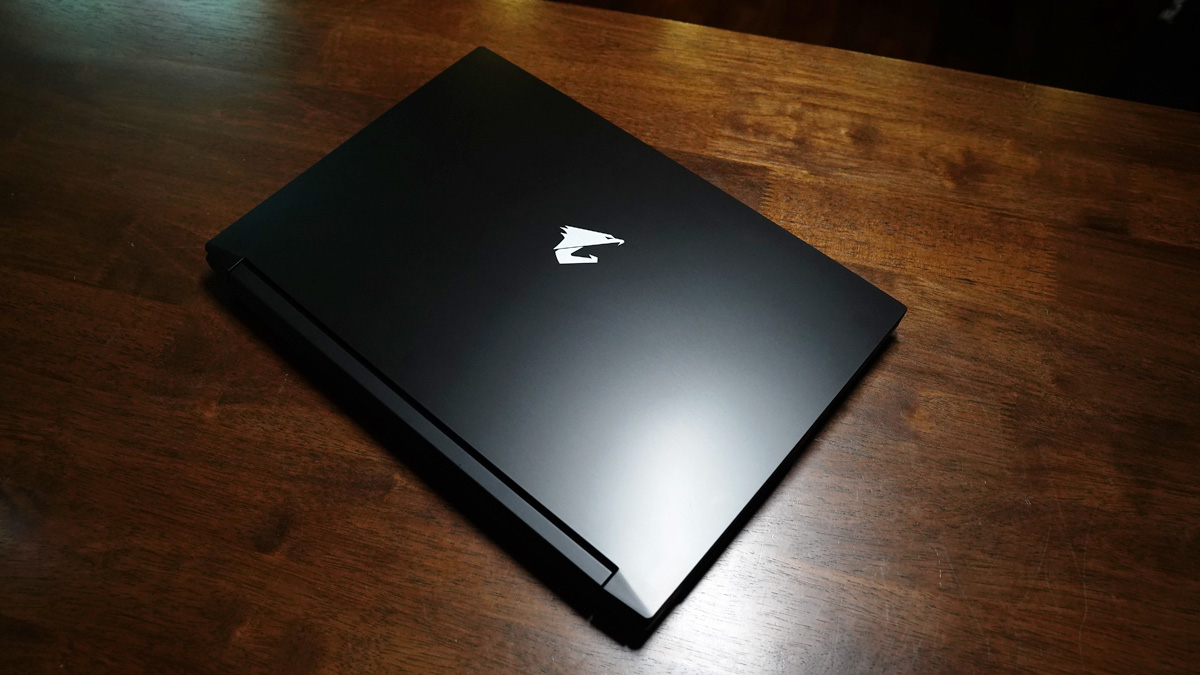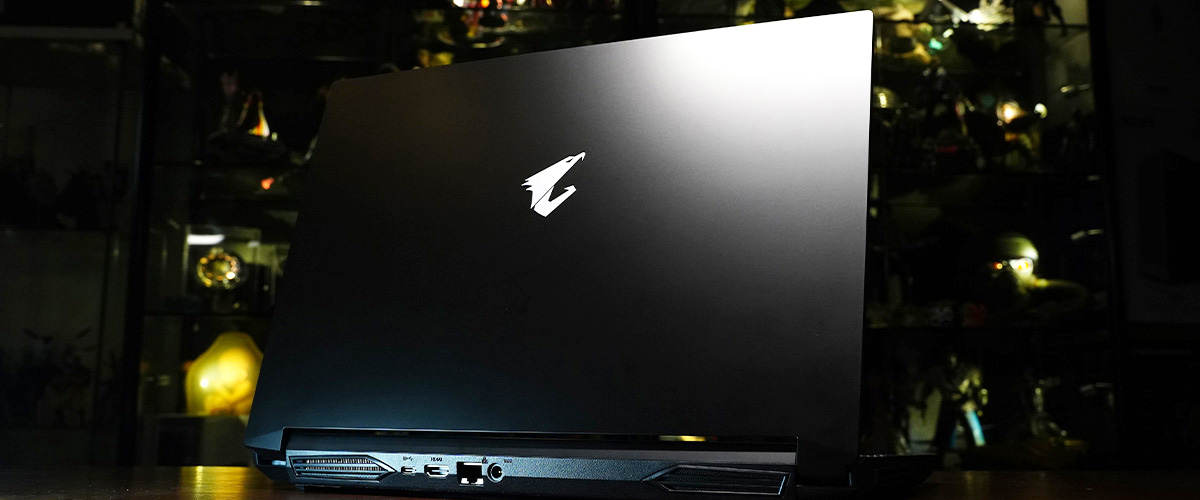Thanks to the advancements in technology and hardware, gamers are now in an era of technology that prides itself more on presentation than actual depth and complexity, with many tech companies constantly vying for top spot as the be-all, end-all for PC gaming.
For every top-of-the-line ASUS ROG, Razer, Lenovo or Alienware gaming laptop available in the market, there also exists a niche catered toward gamers on a budget. But what used to be in the realm of smaller, boutique PC makers has slowly made its way to the bigger boys. The Gigabyte Aorus 5 SB is one example of a machine that is a slightly more accessible alternative for gamers who want to experience the latest and greatest, but don’t exactly have the money to shell out for the best gear around.

After all, top speed is one thing for a car, but even the best of casual drivers won’t have the roads or ability to ever hit that, as gamers do not always need to be hitting the recommended top specs to enjoy a game. Instead, it’s about hitting the minimum, to be able to play games at a decent speed and capacity.
At S$1,979, the Aorus 5 SB is definitely a value-for-money option compared to the sub-S$3,000 gaming laptops available today. Packed with hardware including the latest Intel Comet Lake processor and an NVIDIA GTX 1660 Ti graphics card, this isn’t a sports car in the proverbial sense, but it’s a reliable machine capable of running most AAA games smoothly at scaled-down settings.
Here are the specifications of our review unit:
- Processor: Intel Core i7-10750H (2.6GHz – 5GHz)
- Graphics: NVIDIA GeForce GTX 1660 Ti GDDR6 6GB
- Memory: 16GB RAM DDR4
- Storage: 512GB M.2 PCIE SSD
- Price: S$1,979
At first glance, one might easily mistake the Aorus 5 SB for the Aftershock Forge 15 series laptops, as they share the same OEM chassis, with a few visual tweaks here and there. That said, its stealthy exterior makes it fit seamlessly into office and school settings, should you happen to find the need to bring it out of the house. It measures 361mm by 258mm by 27.9mm, and weighs around 2.2kg, which is about the standard for similarly-built laptops, which makes this quite a cumbersome machine to carry around. Thankfully, its 180W power brick isn’t at all that bulky, so the most trouble you might get out of bringing this laptop around is the main unit itself.


Having been manufactured using the exact same OEM chassis as the Aftershock Forge 15, this is probably inevitable given the plethora of bands that use OEM parts to reduce production costs. This is also evident in an otherwise plain-looking exterior that neither looks nor feels premium at all. The chassis seems to use a hard plastic material that seems to bend rather easily especially on the hood, almost threatening to snap out of place if we applied a bit more pressure.
Additionally, the hinge where the laptop flips open also feels a little shaky. This laptop unfortunately doesn’t seem at all that durable as its tank-like appearance suggests, so one will have to exercise caution when handling it, not that you should be throwing this around without a care.


Under the hood, the Aorus 5 SB sports the exact same full-size keyboard as the Aftershock Forge 15, which, in this case, isn’t actually a bad thing. The keyboard feels super responsive and tactile, and even has a numpad to boot for additional utility – something that most other gaming laptops ditch altogether. This makes it great not just for playing MMORPGs such as Final Fantasy XIV and World of Warcraft, but also doing work on the likes of Microsoft Excel.
However, it tends to be a bit of a fingerprint magnet. From just two weeks of use, we’ve already started to see fingerprint and sweat marks on some of the keys. As such, you might want to either invest in an external keyboard to preserve the integrity and look of the laptop when hunkered down on a desktop, though using it as is on your travels may be a bit of an inevitability.
In terms of ports, here is what the Gigabyte Aorus 5 SB has:
- 1x USB2.0 Type-A
- 1x USB3.2 Gen1 Type-A
- 1x USB3.2 Gen2 Type-A
- 1x HDMI 2.0(with HDCP)
- 1x Mini Display 1.2
- 1x DisplayPort 1.4 Type-C over USB 3.2 Gen 2
- 1x Audio combo jack
- 1x Microphone jack
- 1x SD Card Reader
- 1x DC-in
- 1x Ethernet port



That’s a healthy amount of ports present on this laptop, and instantly one that gives it an advantage over its pricier counterparts. The presence of an SD card reader is always welcome on a gaming laptop such as this, especially for gamers who also happen to be content creators who shoot a lot of photography and/or video. However, having so many ports also creates the inevitable possibility of the Aorus 5 SB looking like a grotesque octopus or spider, with so many dongles and cables sticking out of it from the back and the sides.
The 15.6-inch display is an IPS-level anti-glare Full HD LCD panel, with the most striking feature being its native 144hz refresh rate. For a budget laptop, such a display would be considered a luxury, but somehow it made its way onto the Aorus 5 SB, and looks extremely good when watching content, editing photos and videos.
More importantly, this makes playing games an absolute breeze, especially competitive shooters and MOBAs, which require players to be constantly on their toes (read: fingers) with split-second reactions.
Here are the various benchmarks that we performed on the Gigabyte Aorus 5 SB:
PC Mark 10

Geekbench
- Single-Core Score: 1256
- Multi-Core Score: 5468
Cinebench R15
- OpenGL: 144.95 fps
- CPU: 1082 cb
Unigine Heaven 4.0
- FPS: 88.5
- Score: 2230
- Min FPS: 8.9
- Max FPS: 191.3
As the various benchmarks suggest, the Aorus 5 SB is really none too shabby in its overall performance. That said, its 1660 Ti GPU, while none too shabby, won’t be able to run the likes of The Witcher 3, Red Dead Redemption 2, and the more recent Cyberpunk 2077 smoothly at Ultra settings, it certainly is able to get said games running at a constant 30fps at scaled-down settings, and having the likes of ray-tracing and DLSS turned off.
Of course, it truly shines when running the likes of Overwatch, Dota 2, and League of Legends. These competitive titles don’t require the PC or laptop to be the most advanced spec-wise, which makes playing them on the Aorus 5 SB an absolute breeze. The 144Hz display complements the fast-paced nature of these games, and players will certainly appreciate the ability to make the most out of the refresh rate with a constant 60fps throughout these titles.

While the Aorus 5 SB was running these games and benchmarks, it seemed to remain at a relatively comfortable temperature. This is thanks to the Windforce cooling system that Gigabyte has installed on the underside of this laptop. While the Aorus 5 SB shares the same OEM chassis as the likes of the Aftershock Forge 15, it makes the most out of the vents on the bottom and and sides, and didn’t seem to overheat even while running more graphically-intensive titles like Cyberpunk 2077. Granted, it isn’t exactly cool (pun not intended), but it’s not blisteringly hot so it can actually sit comfortably on your lap.
Speaking of which, one massive downside we’ve encountered on the Aorus 5 SB is its poor battery life. On average, it lasted for an underwhelming hour while running Overwatch before requiring to be hooked to power. This makes this laptop only suitable for the desktop life, as it can barely last an hour on its own. But of course, if you’re intending to use this laptop as your main computer, then this shouldn’t be an issue.

Overall, the Gigabyte Aorus 5 is a good example of making the most out of a limited budget. Not every budget laptop can boast that it has the latest Intel Comet Lake processor, a slick 144Hz display, and decent cooling, all for just under S$2,000. That’s quite a good deal all things considered. But of course, with a limited budget, it’s clear that sacrifices had to be made, with cheap material for the chassis and an almost-nonexistent battery. But if you can look past these flaws, this is actually quite a solid gaming workhorse.
GEEK REVIEW SCORE
Summary
As far as entry-level or budget gaming laptops go, the Gigabyte Aorus 5 SB is a relatively solid option for gamers who want something that functions reliably well. But for all its technical prowess, don’t settle on this if you’re looking for something durable or can survive without being connected to power for extended periods.
Overall
7.4/10-
Aesthetics - 7/10
7/10
-
Build Quality - 7/10
7/10
-
Performance - 8/10
8/10
-
Value - 8/10
8/10
-
Geek Satisfaction - 7/10
7/10
Marion has a serious RPG addiction. Sometimes it bleeds into real life; he forgets to sleep because he thinks he has a Witcher’s body clock. Forgive him in advance if he suddenly blurts out terms such as “Mind Flayer” and “Magic Missile”, because never once does he stop thinking about his next Dungeons & Dragons game.












